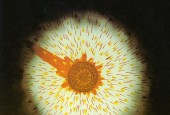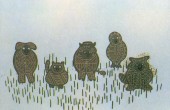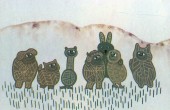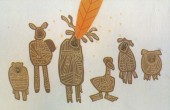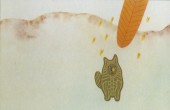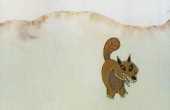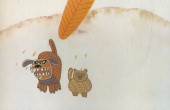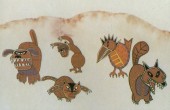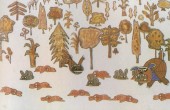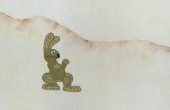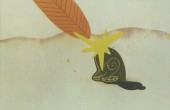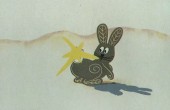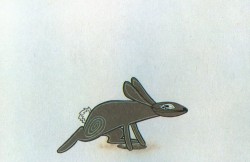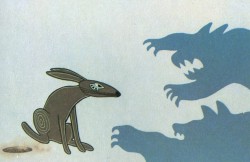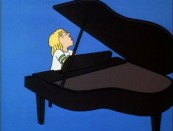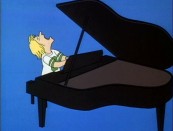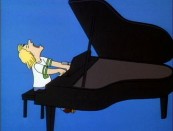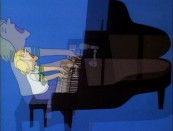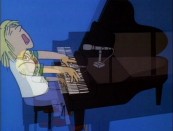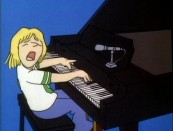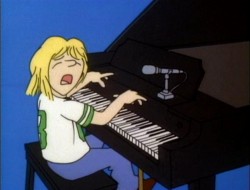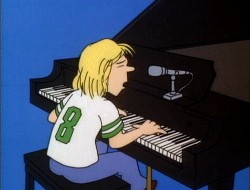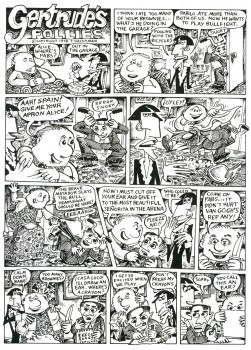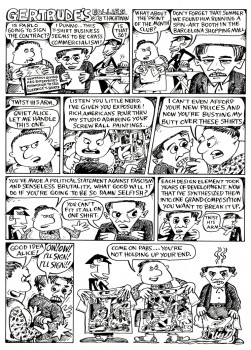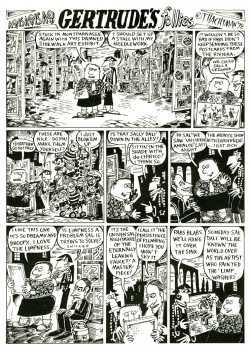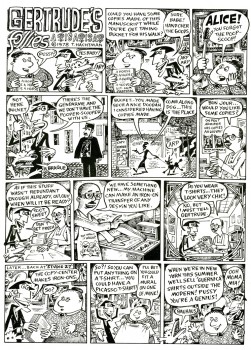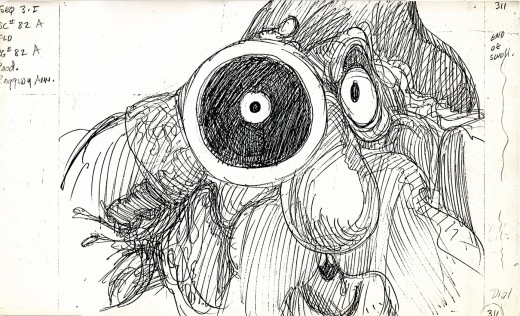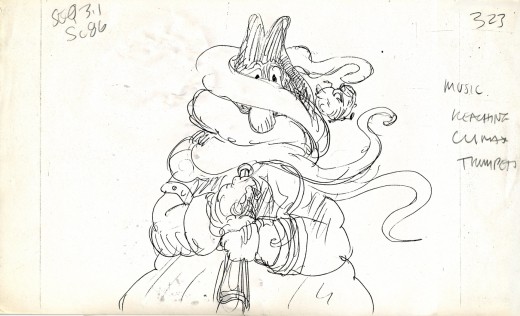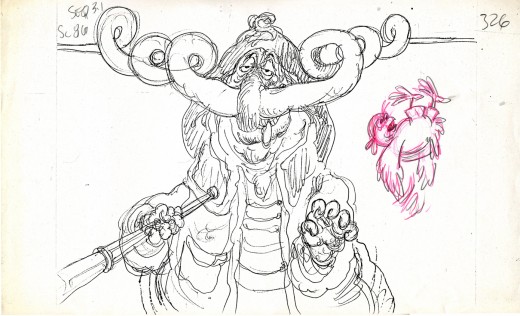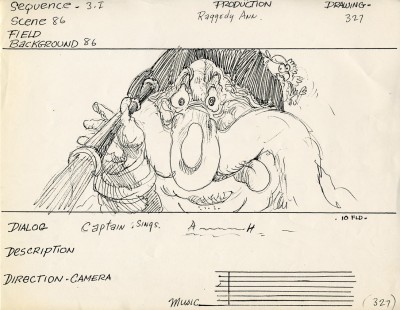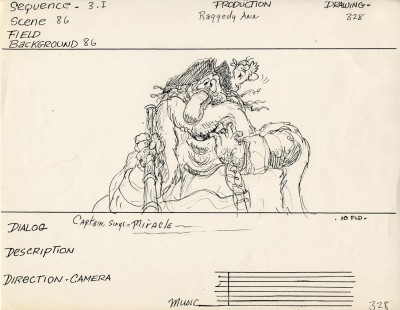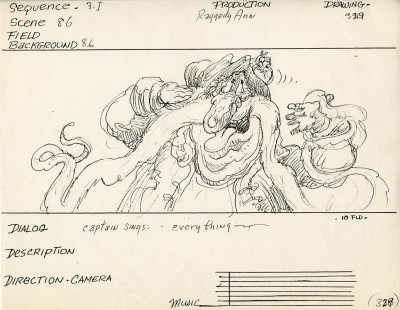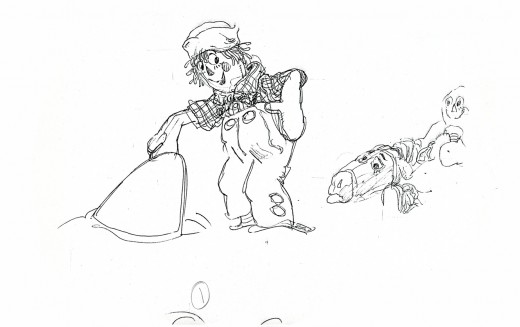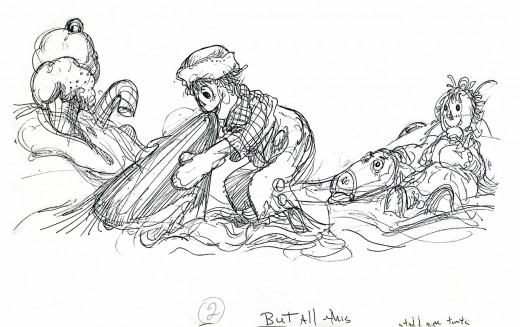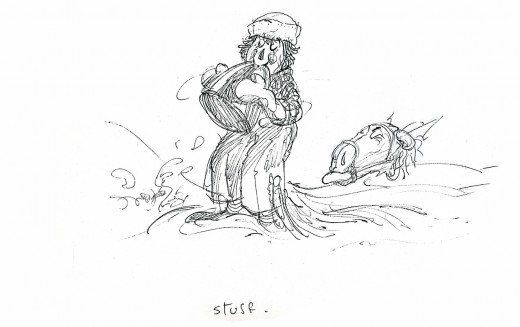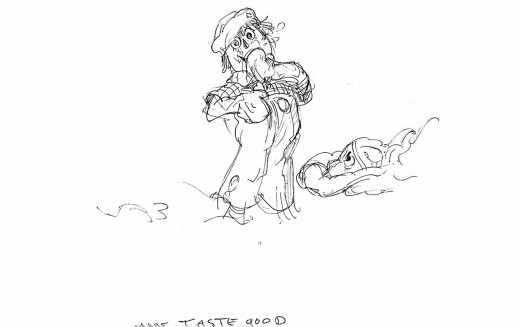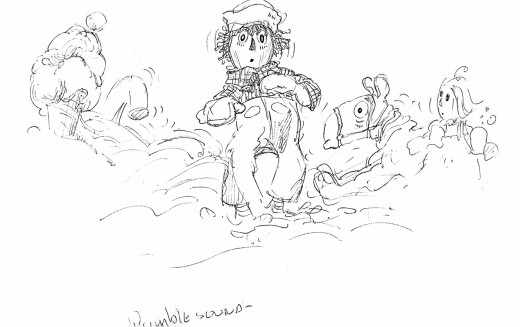Search ResultsFor "raggedy"
Animation Artifacts &Hubley 10 Feb 2007 08:44 am
Watership Down Down Down
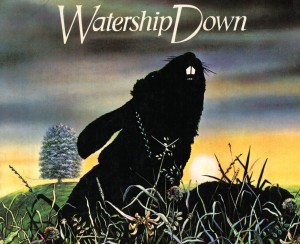 – Yesterday, Mike Barrier expressed some angerl on his site regarding sloppy animation history. He takes to task Stephen Worth and a couple of others.
– Yesterday, Mike Barrier expressed some angerl on his site regarding sloppy animation history. He takes to task Stephen Worth and a couple of others.
I couldn’t agree more with him regarding bad history on the internet. Errors appear everywhere, not just the internet but on these classic dvd’s we buy. (e.g: There’s conflicting information on #3 of the Looney Tunes set’s comment-ary tracks. It’s annoying. Since I particularly trust Barrier‘s accuracy, I went with his version.)
(Click any image to enlarge.)
I give you this information by way of introduction to some probably poor history I’ll present. Everything I offer is guess work. Unlike some others who are overconfident about their guess work, I’m emploring anyone who has conflicting information to let me know so that I can straighten the record and learn the truth, but I do feel somewhat confident.
The subject is John Hubley‘s involvment on the feature Watership Down.
I made some comments a couple of days back about Doonesbury and it prompted a question by David Nethery which started my rambling in response. I decided to add a couple of illustrations, and it’s evolved into this post.
There is no doubt in my mind that Hubley planned and shaped the opening sequence built around aboriginal art. Australian production designer, Luciana Arrighi often gets credit for this. However, I am sure Hubley put it into action and directed it. It’s his style. Perhaps it’s his style by way of Luciana Arrighi, but in the end it came out Hubley‘s.
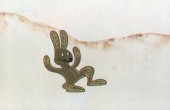
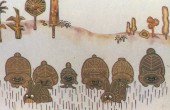
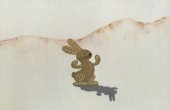
Also obviously his is the guiding spirit of the Black Rabbit of Inle which appears throughout the film particularly after the death of Hazel.
Bill Littlejohn, Phil Duncan, Ruth Kissane, and Barrie Nelson – all Hubley regulars – acted as animator or animation directors on the film. I think they visited the studio in England, but most certainly worked freelance from their homes. A guess – strictly a guess – is that Phil Duncan animated that opening. It feels like his work to me.
I was not in touch with John during this feature or after he had been pushed out of it. At the end of Everybody Rides The Carousel I moved over to Raggedy Ann. Dick Williams had been a hero of mine since the late sixties when I learned of his work. I’d had a number of letters back and forth to his Soho studio, and I contemplated the trip to show him my art. (How much easier everything is with the internet!)
As Carousel wound down, I watched closely as Dick competed for the Raggedy feature. He worked with Tissa David to do a short pencil test of Ann & Andy dancing to a piano score by Joe Raposo. Shamus Culhane was doing the same for Joe Oriolo. The two presentations went solidly Dick’s way, and he got that film. Tissa presented my name to Dick, and I was offered the first staff position on the upcoming feature.
At the same time, John Hubley was offered Watership Down. He had made the comment that he’d like to do the job that Halas & Batchelor had blown with Animal Farm, and he thought this could be the film fo that. This was a very exciting prospect to my ears. However John didn’t want me to go to England. I sure would have followed if he’d asked.
He asked if I would stay in New York and manage his studio there. He thought it might be possible to do some work in New York while he did the film in London. We even negotiated a very meager salary (John was the tightest guy I knew. He’d faced bankruptcy several times and watched his money closely.) Ultimately, watching what was about to happen half a mile away was too enticing for me. I wanted the chance to work with Dick Williams who had already brought on board Art Babbitt, Emery Hawkins, John Kimball, Gerry Chiniquy, Corny Cole and others. My allegiance was more with Tissa by this point, and I made my decision.
So, my analysis of the scenes I see is based solely on my love of Hubley’s work. I’ve inbetweened and inked and colored thousands of Phil Duncan’s drawings and scenes, and I’ve designed for John Hubley knowing full well that every drawing I was to do under him came out looking like a Hubley film. (John was the best artist I’ve ever met, so no one, in my opinion, could match what he could do with the simplest of lines.) I think my speculation on these short scenes in Watership Down is correct. I hope anyone won’t prove me wrong, but there it is.
There’s a very nice piece on the web by Richard Bell about his work in BG’s under Hubley and Martin Rosen.
There’s also an extensive and very insightful piece by Chris Boyce with analyzes the film in depth. He tries hard to separate what might be Hubley’s from Rosen’s.
Daily post &Hubley &Tissa David 07 Feb 2007 08:16 am
Doonesbury
- The 1977 Hubley film of Gary Trudeau‘s Doonesbury Special has just shown up on YouTube. It comes in five parts. This is the film that was the last started by John Hubley.
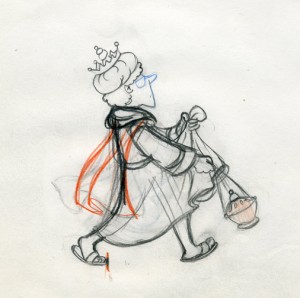 The Hubley Studio was an apartment on the Upper East Side of Manhattan. It was always crowded with beautiful, framed art: paintings by John and Faith, Backgrounds from their films, and the more attractive awards given to them.
The Hubley Studio was an apartment on the Upper East Side of Manhattan. It was always crowded with beautiful, framed art: paintings by John and Faith, Backgrounds from their films, and the more attractive awards given to them.
Stepping into the apartment/studio was like stepping into an art gallery brimming with modern art. I always felt like I should be whispering.
Fresh off Raggedy Ann & Andy, I was brought on board the show to assist John. I had missed the prior 18 months while John was in London working on and getting over the Watership Down debacle. ***
(One of Tissa’s 24 drawing walk cycle. Someday I’ll
post them all with rougher preliminary sketches.)
Returning to the studio was both a joy and a shock. All that great art, had Doonesbury strips ripped out of the newspapers and taped over all the framed Hubley art. I found it embarrassing given how great the art was underneath those strips.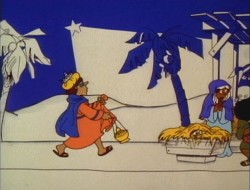
The show was just barely getting started. Actors had just started recording. John, Faith and Gary spent many of their days at the studio recording while I started development of the film’s art from the storyboards.
Kate Wodell, one of Hubley’s talented ex-students from Yale who had worked through Everybody Rides the Carousel, was the only other person on staff; I think she started a few days after me.
(Click any image to enlarge.)
Gary and I didn’t really speak more than to say hello, but it was obvious that he and I didn’t really get along. John strongly held onto me, and wouldn’t alow me to leave or be left.
However, about a month into the work, he called me to his room. John told me that he had to lay me off for a couple of weeks. He was about to go into the hospital for an operation up at Yale, and would halt work until his return.
John Hubley didn’t return. He died on the operating table.
After a short period, Faith announced that they would finish the film in John’s honor, and she and Gary Trudeau would direct in tandem. I decided not to return. I took a job assisting R.O.Blechman direct his first one-hour special, Simple Gifts.
About a month into my work, I got a call from Tissa David. She was animating the class play in the Doonesbury Special, and she needed help. She couldn’t find an assistant who could keep up with her on the schedule she had to meet for them. About 100 feet a week of pretty full animation.
I agreed to work free lance on Tissa’s work for Faith. During the day I was an Asst. Director on one PBS Special; at night I was an Asst. Animator on another CBS Special. When I completed Tissa’s scenes – about a month’s work – I got a call from Kate Wodell. Ruth Kissane had animated a piano rotating 90 degrees with a character playing the piano on another level, but she’d left many of the drawings for an assistant. No one at the Hubley studio could do it, and they asked if I would help out. I did the scene which took about a week.
Unfortunately, that was the last time I worked for Faith, even though we remained close up to her death.
(This is Ruth Kissane‘s sequence. I have the original drawings somewhere and
I’ll eventually post them.)
*** (I’m sorry this was not written clearly. I do not think Watership Down, the film, was a debacle. John Hubley’s involvment with the film and his treatment by Producer, Martin Rosen, was. See my comment below.)
Comic Art &Illustration &T.Hachtman 27 Nov 2006 08:20 am
Gertrude
- Back in the late ’70s, there was a local newspaper that competed with the Village Voice for the alternative audience. The Soho News was smaller and thinner, but had its own treasures. Some good writing and listings, and many excellent alternative comic strips. (Bill Plympton had a weekly strip in this paper before he started animating.)
I fell in love with one comic strip called Gertrude’s Follies to the point where I waited 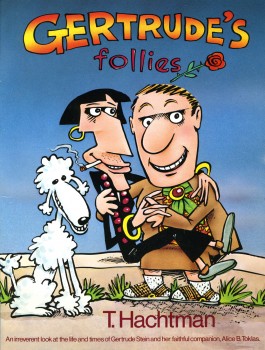 each week for the new issue and the new strip to hit to market. It was about Gertrude Stein and Alice B. Toklas and all the crazies that came into their lives – particularly Picasso, Hemingway and other iconic art types. It didn’t matter that Matisse and Capote didn’t meet; they were both available for the strip – as was everyone else.
each week for the new issue and the new strip to hit to market. It was about Gertrude Stein and Alice B. Toklas and all the crazies that came into their lives – particularly Picasso, Hemingway and other iconic art types. It didn’t matter that Matisse and Capote didn’t meet; they were both available for the strip – as was everyone else.
Finally, after enjoying it for so long, I decided to locate the cartoonist behind it, and see whether he was interested in developing a storyboard and script for a feature. Maybe we could get some low-budget financing.
Tom Hachtman was the cartoonist, and he was a brilliant artist. His wife, Joey Epstein, was another fine artist. The two entered my life at this point, and some interesting things developed.
Gertrude’s Follies was an ongoing project. Tom worked with Maxine Fisher, who has been my writing partner through all the years of my studio. The two of them developed a couple of themes from the mass of strips that had been done and started to weave a storyboard. Tom left 4 or 5 panels of each 6 panel page empty, and I constructed and reconstructed story around them. Sometimes I would draw more material, sometimes I would take some away. It was real fun.
The Soho News folded, and no one really picked up the strip. It ran for a short time in The Advocate. Tom was able to publish a collected book (see the cover above.) You can still locate a rare copy on line.
Some newer, color copies of the strip can be found on line here.
Tom also does some political cartoons for the site here.
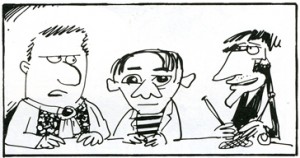 The movie never went into production. I couldn’t raise the funds – my inexperience. We did make one short segment – a two minute piece that was the most hilarious strip. Sheldon Cohen, an animator I met at the Ottawa 76 festival, came to NY when I offered him a job on Raggedy Ann. Sheldon, ultimately, did a number of films for the National Film Board which you can watch on-line if you click on his name.
The movie never went into production. I couldn’t raise the funds – my inexperience. We did make one short segment – a two minute piece that was the most hilarious strip. Sheldon Cohen, an animator I met at the Ottawa 76 festival, came to NY when I offered him a job on Raggedy Ann. Sheldon, ultimately, did a number of films for the National Film Board which you can watch on-line if you click on his name.
Sheldon animated this particularly funny strip. It took a while for him to animate it, and by the time he was finished, the feature had died and I had lost some interest. Years later I inked and painted it and had it shot. The short piece was never finished, though I still think about doing that.
Tom also recently gave me a funny strip about Pablo Picasso sculpture for which I’ve finished a storyboard and animatic. Hopefully, I’ll get the energy to animate it.
Aside from Gertrude, both Tom & Joey worked on a number of my films and still infrequently do. The two have painted many murals on the Jersey Coast, where they currently live. Tom has been a political cartoonist for the NY Daily News, has done lots of airbrush work for Bob Blechman when the Ink Tank was in operation. He also has done quite a few cartoons for The New Yorker magazine.
Here are a few of the strips to give you the flavor. Perhaps next week I’ll give a sample of our storyboard, comparing it with some of the actual strips. Enjoy.
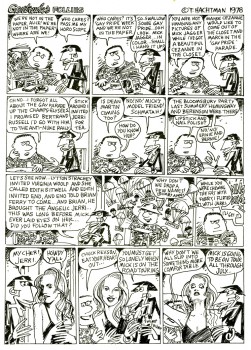 1
1 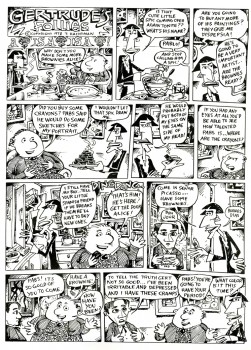 2
2
(Click on any image to enlarge so that you can read the strips.)
Photos &Richard Williams 12 Nov 2006 10:32 am
Raggedy Photo Sunday
- Yesterday, the NY chapter of the Motion Picture Academy screened 32 films to vote on a short-list in preparation for the nominations. It took seven hours of animation viewing, and there were about 20 of us – I didn’t actually take count – in the small Dolby screening room. I was going to comment today, but find I need more time to sort out my thoughts. I’ll do a short commentary tomorrow.
- Anyway, today is photo Sunday.
Having recently pored over some of the artwork from Raggedy Ann & Andy (the NY contingent of the 1977 feature film), I wondered if I had any photos that I could post. There weren’t many that I could find quickly, but the few I did find are here.
The first two stills were taken for the John Canemaker book, “The Animated Raggedy Ann & Andy.” I think only one of the two appears in the book.
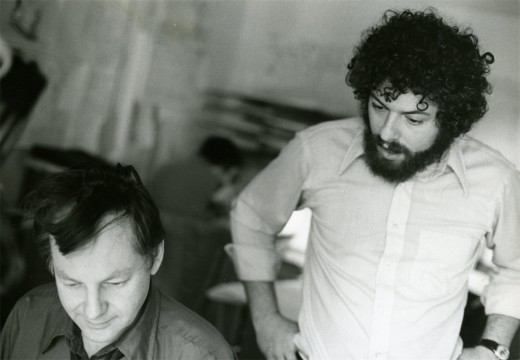
(Click any image to enlarge.)
Obviously, that’s Dick Williams with me looking over his shoulder. Oddly I remember being in this position often during the film. It’s probably the first image I have of the production when I look back on it. Dick and I had a lot of conversations (about the film) with him “going” and me listening.
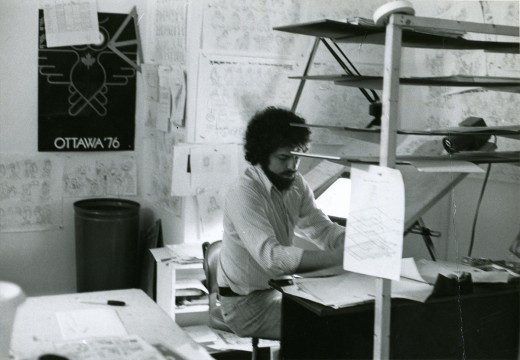
When I did actually grab time to do some drawing, this is my desk. It sat in a corner of a room – across from Jim Logan and Judy Levitow. There were about ten other assistants in my room, and there were about seven rooms filled with assistants on the floor. I had to spend time going through all of them making sure everybody was happy.
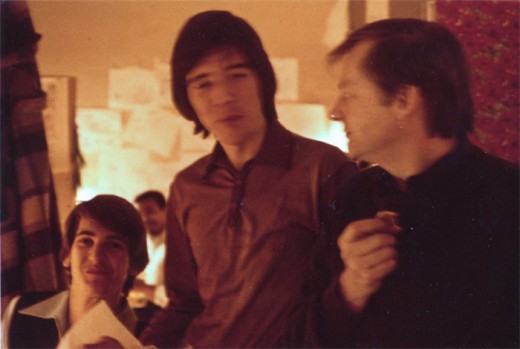
This slightly out of focus picture shows Dick Williams (R) talking with Kevin Petrilak (L) and Tom Sito. That’s Lester Pegues Jr. in the background. Boy were we young then!
These guys were in the “taffy pit,” meaning they spent most of their time assisting Emery Hawkins who animated the bulk of the sequence. Toward the end of the film, lots of other animators got thrown into the nightmarish sequence to try to help finish it. Once Emery’s art finished, I think the heart swoops out of that section of the film.
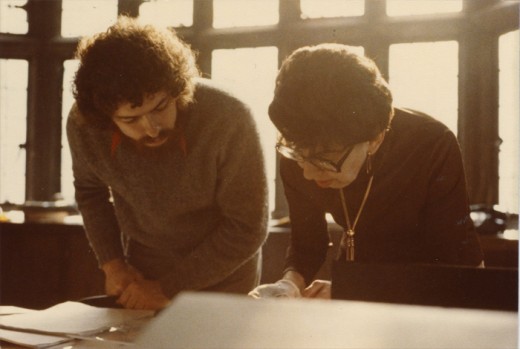
This photo isn’t from Raggedy Ann & Andy, but it just might have been. That’s the brilliant checker, Judy Price showing me the mechanics that don’t work on a scene on R.O.Blechman‘s Simple Gifts. This is the one-hour PBS special that I supervised after my Raggedy years. However, Judy was a principal on Raggedy Ann, and we spent a lot of time together.
Ida Greenberg was the Supervisor of all of Raggedy Ann’s Ink & Paint and Checking. She and I worked together on quite a few productions. I pulled her onto any films I worked on after Raggedy Ann. She was a dynamo and a good person to have backing you up.
I’m sorry I don’t have a photo of her from that period.
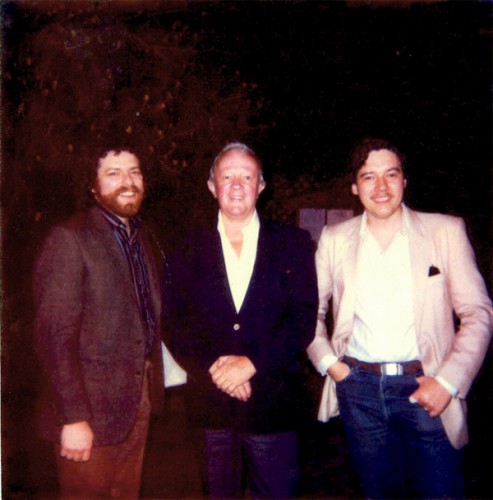
This is one of my favorite photos. Me (L), Jim Logan, Tom Sito (R). Jim was the first assistant hired after me – I’m not sure I was an assistant animator when they hired me, but I was being geared for something. The two of us built the studio up from scratch. We figured out how to get the desks, build the dividers, set up the rooms and order the equipment.
To top it all, Jim kept me laughing for the entire time I was there. I can’t think of too many others I clicked with on an animation production as I did with him. He made me look forward to going into work every day.
We frequently had lunch out, he and I, and I think this is at one of those lunches when Tom joined us. It looks to me like the chinese restaurant next door to the building on 45th Street. Often enough, Jim and I would just go there for a happy hour cocktail before leaving for the night.
I should have realized how important that period was for me and have taken more pictures. Oh well.
Animation Artifacts 25 Oct 2006 07:45 am
Art Lectures
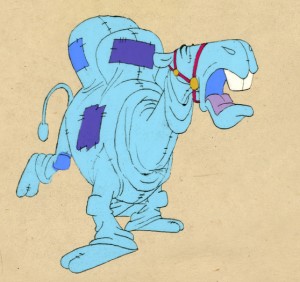 – At the beginning stages of production on Raggedy Ann & Andy, Art Babbitt was brought in to conduct a week’s worth of classes for the small (at the time) staff (and anyone else in the NY animation industry who wanted to attend).
– At the beginning stages of production on Raggedy Ann & Andy, Art Babbitt was brought in to conduct a week’s worth of classes for the small (at the time) staff (and anyone else in the NY animation industry who wanted to attend).
He basically taught principles of inbetweening. This is much the same material he taught at Dick’s studio in Soho Square. About 50 people attended and we all kept our own notes. There were also Dick’s lecture notes from the London classes. These were handed out, behind the scenes, to anyone who wanted them.
Dick and Art also wrote a joint article for Sight & Sound in the Spring 1974 issue. In it, Art analyzes the character of Goofy, and Dick analyzes the character of Art. That article follows:
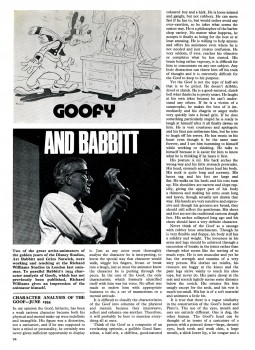 1
1 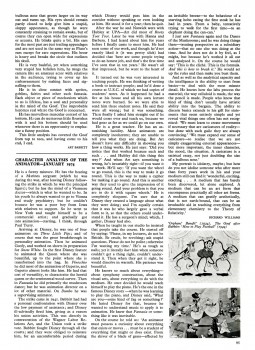 2
2
(Click on any image to enlarge.)
Animation Artifacts 14 Oct 2006 08:23 am
More Corny
- My recent posting of art from Raggedy Ann & Andy prompted John Celestri to send me this clipping from the Cincinnati Enquirer re the kidnapping of Ann & Andy.
- Here are some more of Corny Cole‘s story board drawings from Raggedy Ann & Andy.
This first Layout marks the introduction of Raggedy Andy. He’s under the box. This drawing gives you a good idea of the detail Corny put into every drawing.
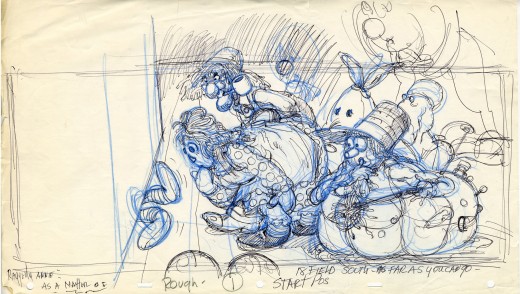
(Click on any image to enlarge.)
The following images come from the first shots of the Pirate Captain. He espys the new doll, Babette, and falls madly in love.
The first four stills are 8.5×14 copies of the storyboard; the remainder come from the director’s workbook. They’re all sequential.
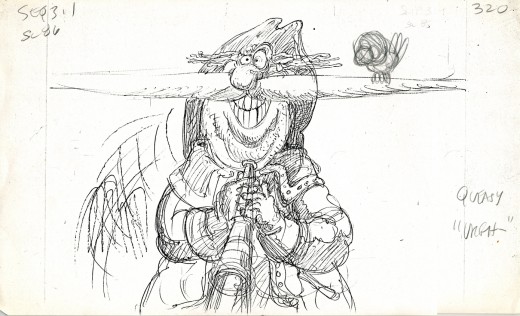
I think the parrot, which was added in pencil, is the work of Asst. Director, Cosmo Anzilotti. The bird just shows up later, so Cosmo probably tried to give him some business.
It’s here that the Pirate goes into his song (everybody sings in this film) and concocts his plot to kidnap the French doll.
Animation &Animation Artifacts &Richard Williams 12 Oct 2006 07:54 am
Andy & Corny
- Seeing the models David Nethery posted on his site, You’re A Gazelle, in his comments on Tissa David‘s work from Raggedy Ann, started me thinking about the Dick Williams‘ film. As I noted, yesterday, I have quite a bit of artwork from the film, and I thought I should post some.
I think in ways, the unsung hero of Raggedy Ann was Corny Cole. He was there from day one working with Dick and Tissa – once the one minute pilot had gotten the job for Dick. Corny was brought in as the key designer, and Gerry Potterton came on as Dick’s Associate Director.
I was hired soon thereafter, even though I had no idea what I’d be doing. For the first couple of weeks, while they were recording, I just moved furniture and read the script and whiled away the time by drawing Johnny Gruelle‘s characters.
I helped Dick and Gerry add spot coloring to the storyboard as the animatic was being shot. We spent a long Saturday coloring like mad with colored pencils. We worked on the last section of the animatic to be shot. I’d say 90% of the board was done by Corny. Dick and Gerry added spot drawings as needed, while we built the animatic.
Corny then did lots and lots and lots of drawings to give to animators.
Some of those drawings are posted herein for a scene at the beginning of the “taffy pit” sequence. These drawings were also used in the animatic.
After Corny finished feeding the animators, he started animating, himself. He took on a sequence that filled the screen with a pirate ship full of dolls floating around some rough waters. The large sheets of paper were filled with Corny’s black bic pen lines. Doug Compton eventually worked with Corny to finish this overworked sequence.
Daily post 11 Oct 2006 08:37 am
Watching
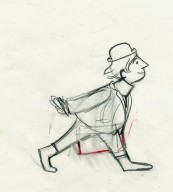 - David Nethery at his site, You’re A Gazelle, has taken Tissa David‘s drawings from Upkeep, which I posted yesterday, and has made a QT movie of them.
- David Nethery at his site, You’re A Gazelle, has taken Tissa David‘s drawings from Upkeep, which I posted yesterday, and has made a QT movie of them.
You can find this and a nice posting about Tissa there. David also offers a number of models and images from Raggedy Ann to illustrate his post. I have quite a few scenes of drawings from Raggedy Ann and hope to post them sometime soon. It takes a bit of patience since the drawings are all so large and have to be reconstructed after I’ve scanned them. That takes some time.
- Comic fans will be delighted with the latest post from the ASIFA Hollywood Animation Archive. Several Sunday pages from Rube Goldberg‘s Side Show are posted. Worth a reading.
- Gary Trudeau has kept his comic strip, Doonesbury, alive with political commentary on the “war” this country is fighting. He also now has set up a blog, called The Sandbox, for members of the service to comment on anything they’d like. David Hinckley in the NYDaily News has a review-of-sorts of this work.
- I’ve seen two films recently and both are good in very different ways. Both are intelligent adult movies, and both are headed toward the Oscars.
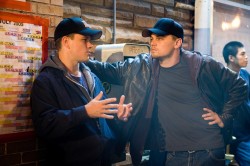 Martin Scorsese is probably one of the most gifted film makers working today. His latest film, The Departed, has some of the year’s most brilliant acting; cinematography that automatically deserves a statue; and imaginitive, inventive direction.
Martin Scorsese is probably one of the most gifted film makers working today. His latest film, The Departed, has some of the year’s most brilliant acting; cinematography that automatically deserves a statue; and imaginitive, inventive direction.
However, the story is a shallow one. It’s adapted from the film, Infernal Affairs, a 2002 Hong Kong crime thriller by Andrew Lau and Alan Mak. William Monahan‘s script stays faithful to the original and writes a chatty, but tense thriller. The director is unable to make a classic in the mold of Mean Streets, Goodfellas, or even Kundun. This is more like Cape Fear – a film made to be popular. Along the way brilliance pops out and it will be deserving of many of the awards it will win.
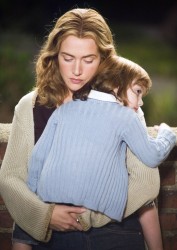 Little Children is, in many ways, the opposite of The Departed. It’s script has levels of depth that just keep going. It’s a strong, intelligent, thinking adult film. It talks as much about terrorism and fear in our lives as it does about the value of the little touch – the reaching out to help those around us. Humanity.
Little Children is, in many ways, the opposite of The Departed. It’s script has levels of depth that just keep going. It’s a strong, intelligent, thinking adult film. It talks as much about terrorism and fear in our lives as it does about the value of the little touch – the reaching out to help those around us. Humanity.
The film’s stars, Kate Winslet, Jennifer Connelly, Patrick Wilson all turn in bravura performances totally in service to the film. The direction, photography, art direction are all subservient to the story. One just wishes it had more flair. Todd Field, the director (whose past credits include In The Bedroom and Aqua Teen Hunger Force) doesn’t bring a sweeping imagination to the visuals, but he does tell his story. Perhaps that’s all that’s needed when the story is so good.
Animation &Photos 04 Oct 2006 08:24 am
An Estonian Connection
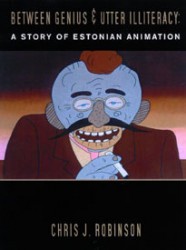 – While in Ottawa, I came across Chris Robinson’s most recent book, Between Genius and Utter Illiteracy – A Story of Estonian Animation. This is released by John Libbey Publishing through the Indiana University Press in the U.S. There’s an excellent, in depth review at AWN, and, since I haven’t yet read the book, I don’t intend to review it now.
– While in Ottawa, I came across Chris Robinson’s most recent book, Between Genius and Utter Illiteracy – A Story of Estonian Animation. This is released by John Libbey Publishing through the Indiana University Press in the U.S. There’s an excellent, in depth review at AWN, and, since I haven’t yet read the book, I don’t intend to review it now.
I’m glad Chris has written it since I think it’s a subject worth visiting. The Estonians have been producing films for many years, and I’m glad for them to get a bit of attention.
Aside from their own films, they’ve also been doing some outsourcing work for other European studios. Since the fall of the Soviet Union, they’ve actually become one of the dominant producers of animation in Russia.
The book focuses on a few particular artists in their history.
- Now let me tell you something about me. Back in my days of Raggedy Ann, 1976, I was contacted by a friend from my Navy years. He was a Russian interpreter working for Columbia Management in NY. He toured with Russian groups (such as the Bolshoi Ballet) around the US interpreting for them.
He had in his charge 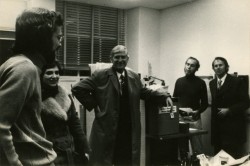 two Russian animators and thought they might get a kick seeing a studio. Since I understood a bit – a very little bit – of Russian, I might be able to help. A little adventure.
two Russian animators and thought they might get a kick seeing a studio. Since I understood a bit – a very little bit – of Russian, I might be able to help. A little adventure.
I asked Richard Williams if we could tour the studio on a Saturday, and he said absolutely not. He didn’t want Russians in his studio. OK. Faith & John Hubley were out of town, so we couldn’t go there. Howard Beckerman‘s small studio was in the same building as Raggedy Ann, and he said yes.
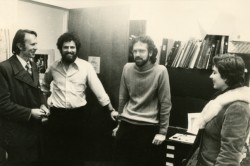 On a very cold January day, they met us, and we went up to visit the two colorful rooms of Howard’s small studio. The animators were delighted, and we had a good hour or so.
On a very cold January day, they met us, and we went up to visit the two colorful rooms of Howard’s small studio. The animators were delighted, and we had a good hour or so.
The animators were Svyatozar Rusakov and Rein Raamat.
Rusakov was from Soyuzmultfilm and had created the most popular series of children’s films in Russian animation history – the Nu Pogodi series.
Raamat was from Estonia and spoke Russian haltingly (something we had in common.) However, he told me he’d recognized my name from the few Hubley films he’d seen. I’d gotten credit, and they played in Russia.
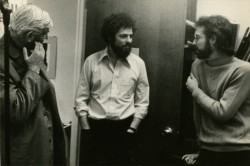 Having a car, I offered to take them wherever else they wanted to go in New York.
Having a car, I offered to take them wherever else they wanted to go in New York.
Svyatozar Rusakov wanted to go to Delancey Street and buy lots of jeans that he could bring back and sell for a lot of money. After returning him and his black-market goods to the hotel, we picked up Rein Raamat. He wanted to go to the Museum of Modern Art to see a particular Modigliani painting in person. He told me he’d never seen any of his actual paintings just prints. Modigliani was his favorite painter. We did that.
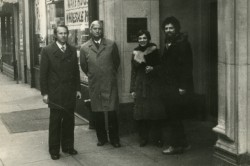 As Rein came face-to-face with the painting, he stopped in shock. Tears came down his face, and I knew I liked this man. After he returned to Estonia, I sent him a coffe-table book on Modigliani; he sent me a book on Bosch and some tour guides of Estonia. We exchanged a number of letters – both of us wrote in our pigeon-Russian. I met him at several film festivals. A couple of years ago he sent me a sad note that he was no longer drawing as the head of the studio, and he wasn’t as happy. I hope to meet him again someday.
As Rein came face-to-face with the painting, he stopped in shock. Tears came down his face, and I knew I liked this man. After he returned to Estonia, I sent him a coffe-table book on Modigliani; he sent me a book on Bosch and some tour guides of Estonia. We exchanged a number of letters – both of us wrote in our pigeon-Russian. I met him at several film festivals. A couple of years ago he sent me a sad note that he was no longer drawing as the head of the studio, and he wasn’t as happy. I hope to meet him again someday.
In preparing this, I noticed on IMDB’s report that Svyatozar Rusakov died in August. I’m sorry to hear that.
I was pleased to see a whole chapter in Chris Robinson’s book devoted to Rein Raamat. I had a short, interesting conversation with Chris about Rein. Now I’d like to read the book.
(All pictures can be enlarged by clicking.)
#1. L to R: (in Beckerman’s studio) Richard Mayer (interpreter), Maxine Fisher, Svyatozar Rusakov, Howard Beckerman, Rein Raamat.
#2. L to R: Rein Raamat, me, Richard Mayer, Maxine Fisher
#3. L to R: Svyatozar Rusakov, me, Richard Mayer
#4. L to R: (outside) Rein Raamat, Svyatozar Rusakov, Maxine, and me.
Daily post &Festivals 19 Sep 2006 07:52 am
Bruno and Ottawa
- In 1976 the first edition of the Ottawa Animation Festival 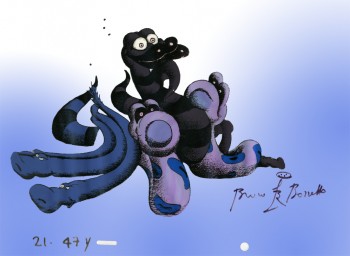 was held. I attended with a contingent of people who were working on Raggedy Ann & Andy, and we were there to be inspired, see a lot of great films and have a good time. One of those times when you felt connected to everyone there.
was held. I attended with a contingent of people who were working on Raggedy Ann & Andy, and we were there to be inspired, see a lot of great films and have a good time. One of those times when you felt connected to everyone there.
Bruno Bozzetto‘s , Allegro Non Troppo was a special midnight screening on the program. A surprise screening; a feature none of us had heard about.
(Click to enlarge.)
Of course, we all knew the work of Bruno Bozzetto. He was undoubtedly a master of comic animation. His films had won enormous prizes everywhere, and his output was large. There’d been many screenings of his films through ASIFA-East, and they were always popular.
The screening was one of the brightest I’ve ever sat through. It was hilarious, beautifully animated, and intelligent. The audience came out excited about animation, alive, and encouraged to party. It was a memorable night and it helped make that festival one of the stand-out Festivals I’d ever attended. I’m sure many there would say the same.
Now the question I have is whether the films of that 1976 festival were as great as I remember or that specific Festival so great? Or was it both? Caroline Leaf‘s masterpiece, The Street, won the grand prize and most of the films were brilliant (including Caroline’s other film The Owl Who Married a Goose.
Allegro Non Troppo just served as the enormous cherry on top of the cake. It was a grand festival and I always hope that others I attend will reach that level.
I look forward to the coming Ottawa Animation Festival starting Wednesday, Sept. 20th. Bruno Bozzetto is both a judge and the recipient of a retrospective of his work. Maybe this will be the one that will match the first.
Tonight ASIFA-East will present a screening of Allegro Non Troppo.
I was scheduled to moderate a Q&A with Bruno Bozzetto, but due to some personal problems of mine Candy Kugel will host it. She’s graciously stepped in to help me out at the last moment, and I have to thank her enormously.
At 6:30 pm – The School of Visual Arts, 209 East 23rd Street, 3rd floor amphitheatre. Admission is FREE.
